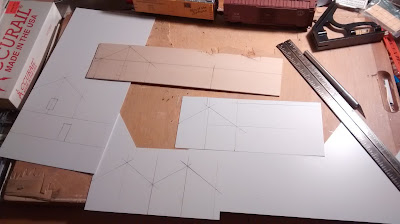Scratchbuilding a Potato House - Pt. 1
While I haven't been particularly active in terms of model railroading so far this month, mostly because I have been unable to settle on a plan and a particular prototype to model. Yesterday, however, I started working on scratchbuilding a model of a potato house. These structures were common through northern Maine, particularly in the county (Whenever I refer to the county, I am speaking of Aroostook County, in northern Maine. Aroostook County is commonly referred to as only "the county" in the part of Maine I am from). Potato houses were ubiquitous in towns located along the Bangor and Aroostook railroad in the county up throuh the 1970s, and I have been looking at building a small layout based on part of the Bangor and Aroostook. Thus, I need to have models of at least one, if not more, potato house for a Bangor and Aroostook layout to look credible.
I decided to scratchbuild my model based on a prototype potato house located in Houlton, Maine. This potato house was located on a short industrial (though it mainly served agricultural warehouses) spur the was located near the railroad's yard on the outskirts of town. I found a picture of this particular potato hpuse online. I can't publish the photo, but you can see the picture here. I thought that this potato house would make an interesting model to build as it is built on the inside of a curve. If I do decide on building a layout based on the Bangor and Aroostook, I will build more mundane potato houses later.
I estimated the dimensions of the potato house from the photo and from 40 foot boxcars I had on hand. The two main walls of the potato house are 30 and 35 scale feet long, respectively, and are 14 scale feet high. The end walls are 24 scale feet wide. The potato house appears to have been built with plain boards placed side by side, and I used both styrene v-groove siding and scribed wood sheet to represent the siding. I would have used wood sheet for the entire structure, but I did not have enough, and I managed to scrounge up the styrene siding is a suitable stand in. I have never combined wood and styrene siding in one building like this before so I am hoping that it will look fine when finished.
This evening, I managed to get the walls all measured and cut to size. I also attached the windows to the potato house. However, while I was working on the structure, my last good X-Acto knife blade broke, so that has put a stop to my progress on the building for now. Hopefully, I can pick some more baldes soon, but untill then, my progress has ground to a stop. I also need to buy a new paintbrush before I can finish this structure. The paintbrush that I have been using was getting in bad shape, and I recently forgot to clean it off agter using it, so the paintbrush is now all but worthless.
Construction, when it was possible, proceeded quite quickly and I amanged to take a few photos to share here.
Walls all measured and drawn out onto the back of the stryene and wood sheet.
All siding peices cut out, along with window and door openings.
The styrene sheet that I had was only .020 inches thick, so I laminated with this sheet with a peice of plain .020 thick styrene sheet in order to strengthen the walls. I will brace the walls further with sturene strip when I assemble the building. I laminated the rear peice of styrene before cutting the window opening in it. This makes it easier to make sure the window openings line up perfectly. The wall on the left of the photo shows a wall before the window opening was cut, while the wall on the right has had it's opening cut.
Windows and a door attached to the walls. Freight doors will be afded to the putside of the potato house once I have a working knife again.




Nice work, Sam - and what an iconic structure for Maine, too!
ReplyDelete- Trevor (Port Rowan in 1:64)
Thanks Trevor. The potato house should really help set my layout in Northern Maine.
Delete-Sam
Hi Sam,
ReplyDeleteNice work!
You might be able to save that paint brush by cleaning it with lacquer thinner. That stuff will clean paint off anything, I use it to clean my airbrush and hand brushes (acrylics, enamels). Very handy, but smells. Don't apply it to styrene as it will likely melt the plastic. Hey that BAR diesel looks sharp. New? What's the story with that?
Take Care
Rick
Rick,
DeleteThanks for the compliment about the structure. As for the paintbrush, I just bought new ones this afternoon, and the dried paintbrush was in pretty bad shape anyway. I'll keep the tip about lacquer thinner in mind, though, since this problem will probably happen again. The BAR diesel is new. I got it about a month ago, and it is a nicely detailed Bachmann model. It was what inspired me to plan a small layout based on the BAR in the first place. I think that I will post about this diesel.
-Sam